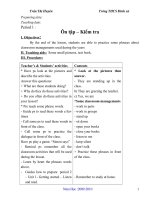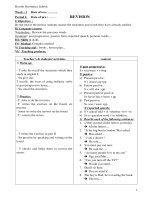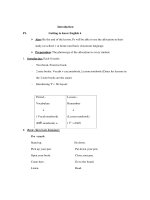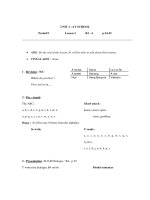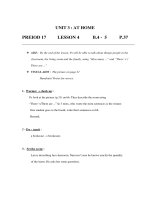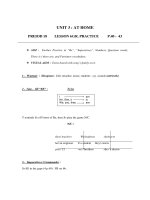giáo án anh lớp 12-unit 3
Bạn đang xem bản rút gọn của tài liệu. Xem và tải ngay bản đầy đủ của tài liệu tại đây (176.75 KB, 18 trang )
Date of preparation: 20/9/2014
Unit 3: Ways of socialising
Lesson: Reading
I. Objectives:
- By the end of the lesson the students will be able to distinguish the term
verbal with non-verbal communication and be up improve their reading
skill by giving meaning to words
II. Method: mainly communicative
III. Teaching aids: Textbook, lesson planning
IV. Procedure:
1. Class organization:
Class Date of teaching Attendances
2. Check-up: Check Ss’ homework
3. New lesson:
Stage Teacher’s activities Students’ activities
Before
reading
- Ask Ss to look at the
pictures, work in pairs to ask
and answer the questions
1. What are the people in the
picture doing?
2. Can you guess what they
say to each other?
3. What will you do / say if:
+ you want to get your
teacher’s attention in class?
+ you need to ask someone a
question, but they are busy
talking to someone else?
-Go around to offer help.
-Call on some Ss to present
their answers and elicits
comments from other Ss. Give
feedback if necessary
- Ask Ss to give the
Vietnamese equivalent (if
- Pairs work
Answers
1.In the pictures, people are
shaking hands and waving with
each other.
2. They may be greeting each
other
3. - If we want to get our
teacher’s attention in class, we
can raise our hands slightly.
- If we need to ask someone a
question, but they are busy
talking to someone else, we can…
- Skim the passage and underline
the new words.
- give the Vietnamese equivalent
-listen and repeat after the
While
reading
necessary).
- Read a new word three
times. Ss listen and repeat
after the teacher.
1.Task 1
-Ask Ss to give the
Vietnamese equivalent to the
following words and phrases.
-Instruct Ss to read the
passage quickly and stop at
the words to guess their
meanings.
-Guess the meaning of the
words based on the context in
the sentences.
-Check that Ss understand the
word correctly.
-Call some students to give
the answers.
- Ask others students to
correct.
- Give the true answers.
teacher.
Copy down
- read the passage quickly and
stop at the words to guess their
meanings.
1.Verbal: bằng lời, hữu ngôn
2. Non- verbal: không bằng
lời,phi ngôn
3. Attract someone’s
attention: thu hút sự chú ý của ai
4. impolite: mất lịch sự
5. Rude: thô tục
6. Informality: thân mật,
không nghi thức
7. Approach: đi đến
8. A slight nod will do: một cái
gật đầu nhẹ là đủ
4. Consolidation: - Retell the main ideas of the lesson.
5. Homework:
- Review the points that have been covered in the lesson and do the
exercise in the exercise book.
- Prepare for next lesson.
Date of preparation:
Period 15: Unit 3: Ways of socialising
Lesson: Reading
I. Objectives:
- By the end of the lesson the students will be able to distinguish the term verbal
with non-verbal communication and be up improve their reading skill by
choosing the best title and answering questions.
II. Method: mainly communicative
III. Teaching aids: Textbook, lesson planning
IV. Procedure:
1. Class organization:
Class Date of teaching Attendances
2. Check-up: Check Ss’ homework
3. New lesson:
Stage Teacher’s activities Students’ activities
Warm up
While
reading
- Ask Ss to play the game :
Hangman with the word
“ Polite”
- Give the true answer
2.Task 2
-Ask students to read the
questions carefully.
- Ask students to read through
the passage again.
- Call some students to give
the answers.
- Ask others students to
correct.
- Give the true answers
3.Task 3: Questions and
answers
-Ask Ss to work in pairs and
ask and answer the questions
in the book basing on the
information in the reading
- Play the game
- Work in pairs
read the passage more carefully &
choose the best title for it.
Answers
A. ( Attracting Attention: Non-
verbal Cues)
- work in pairs and ask and
answer the questions in the book
basing on the information in the
reading passage.
After
reading
passage.
- Ask Ss to read the text again
and write down the answers to
the following questions.
- Move around class to give
help.
-Call on some pairs to present
their answers in front of the
class
- Give correct answers
* Discussion
- Ask Ss to work in pairs to
discuss the meaning of
whistling and hand- clapping
in Vietnamese culture.
- Move around to help Ss.
- Ask some pairs to act out
their conversation.
- T gives feedback.
Answers
1. We can use either verbal or
non- verbal communication.
2. Because they are strong
actions that can easily be seen
3. We can wait until he passes
near us, catch his eye, nod
slightly to let him know we would
like him to come to our table. Or
we may raise our hand slightly to
show that we need assistance.
4. You can use a small friendly
wave to attract his or her
attention.
5. Because it’s considered rude.
- Work in pairs to discuss the
meaning of whistling and hand-
clapping in Vietnamese culture.
4. Consolidation: - Retell the main ideas of the lesson.
5. Homework:
- Review the points that have been covered in the lesson and do the
exercise in the exercise book.
- Prepare the speaking lesson.
Date of preparation: 20/9/2014
Period 16: Unit 3: Ways of socialising
Lesson: Speaking
I. Objectives:
- By the end of the lesson the students will be able to know how to give
and respond to different compliments in certain situations.
II. Method: mainly communicative
III. Teaching aids: Textbook, lesson planning
IV. Procedure:
1. Class organization:
Class Date of teaching Attendances
2. Check-up: Check Ss’ homework
3. New lesson:
Stage Teacher’s activities Students’ activities
Warm
up
Before
speaking
- Have Ss work in groups and give all
the words related to ways of
socializing.
- Call on some Ss to give their answer
on the BB
1. Task1: Practise reading the
dialogue.
- Introduces the task:
- Ask Ss to work in pairs to practise
reading these dialogues
Vocabulary:
-compliments(n) Loi ca tung ,
hairstyle(n)
-terrific(a )Tuyet voi , kidding(a)
- Call on some pairs to practise speaking
in front of the class.
-Comment on Ss' work
-Hang the table on the board. Ask Ss to
look at the information about
compliments in the table.
• Useful language:
Give compliments Respond to
compliments
- beautiful /
perfect
- I’ve never seen…
- terrific /better
I think
-What a/an……you
have/ have got!
-How +
dj/adv…………
Thank you/
Thanks
That’s a nice
compliment
I think
I’m glad you like
it.
Thank you. I
think/ ought……
- Listen to the teacher.
- Work in groups to list all
words related to ways of
socializing ║- verbal
( mouth , talk
- non-verbal (hands,
signal
* Work in pairs to read the
dialogues about giving and
responding to compliments.
- Look at the table on the
board.
- Listen to the teacher.
- Take notes.
use the information in the
table to suitable information
and play the roles in the
dialogues to practise the
dialogues.
- Work in pairs.
listen and look at the
information in the task.
- Some pairs perform.
Others listen to.
David: You really have a beautiful
dress. It is the most beautiful dress
I have seen.
Hung: Your motorbike is really
While
speaking
After
speaking
Thank
2.Task2: Practise giving compliments to
suit the response
-Ask Ss to play the roles in the dialogues
to practise the dialogues.
-Move around to give help
-Read the cues once. Ask Ss to listen
and look at the information in the task.
-Explain the situations of each
dialogues.
-Guide Ss to use suitable compliments in
each dialogues, using the cues.
3. Task3: Practise responding
-Ask Ss to work in pairs, practise giving
compliments to suit the responses.
Move around to give help.
-Call on some pairs to act out their
conversation in front of the class.
-Give comments on their conversations.
-Read the cues once. Ask Ss to listen
and look at the information in the task.
-Explain the situations of each
dialogues.
-Guide Ss to use suitable compliments in
each dialogues, using the cues.
4. Task: Making dialogues to practise
giving and responding to compliments
- Ask Ss to work in pairs, practise
responding compliments to suit the
responses.
Move around to give help
-Call on some pairs to act out their
conversation in front of the class.
-Give comments on their conversations.
terrific. Then…
Michel: I Though your badminton
was a lot better ….
Work in groups.
-Listen to the teacher.
-Act out their conversation
in front of the class.
- Thank you, Phil. I think you
can do it as well as I do.
- Thank you, Peter. That’s a nice
compliment.
You must be kidding. I think it is
acceptable
-Work in pairs
Share with the other pairs.
-Present the dialogues
Take note teacher’s feedback
-A new and expensive watch;
A: You really have a new and
expensive watch, How did you get
it?
B: Thank you, My father bought it
for me on my birthday.
-A new cell phone:
A: Your new cell phone looks
great. I have never seen such a nice
one before.
B: Thanks. I finally found a suitable
one for me
A nice pair of glasses:
A: Your pair of glasses are really
nice. I really like them.
B: Really, Peter. I just bought it
yesterday.
4. Consolidation: - Retell the main ideas of the lesson.
5. Homework:
- Prepare the listening lesson.
Date of preparation: 27/9/2014
Period 17: Unit 3: Ways of socialising
Lesson: listening
I. Objectives:
- By the end of the lesson the students will be able to know which hours
are suitable for calling and avoid telephoning other people at the wrong
time and enhance their listening skill through true or false and blank-
filling exercises
II. Method: mainly communicative
III. Teaching aids: Textbook, lesson planning, cassette tape
IV. Procedure:
1. Class organization:
Class Date of teaching Attendances
2. Check-up: Check Ss’ homework
3. New lesson:
Stage Teacher’s activities Students’ activities
Warm up
Before
listening
While
listening
- Ask Ss to pay the Game:
Hangman with the word ‘
non-verbal”
- Ask Ss to look at the pictures
in the textbook and answer the
questions.
1. What are they doing /
2. What do you think each of
them would say to greet each
other ?
3. What do you think they
would talk about
4. How long do you think it
would take them to finish their
call and why ?
Listen and repeat:
-Help Ss to pronounce the
words in their book correctly.
-Play the tape and then ask Ss
to repeat after the tape in
chorus and individually.
- T corrects errors, if any.
-Check that Ss know the
meaning of these words.
- argument(n) -
regulation(n)
-absolute(a) -
maximum(n,a)
-install(v) - chitchat(n)
starling(a)
1.Task 1: True/False
-Get Ss to read through the
statements to understand them
and underline the key words.
-Guide students the requests
of the task.
- Let students listen twice
time.
- Write on board from 1 to 6
and call some students to
come and write their answers.
- Let them listen on again and
correct.
- Correct.
- Play the game
- Look at the pictures in the
textbook and answer the
questions.
S1 They are talking on the
phone
S2 They say " Hello, How are
you " ?
S3. They may talk about their
friends , their jobs
S4. About 10 or 15 minutes.
- Take notes
- Listen to the tape and read
in chorus & individually
-Individual work, pair work &
whole class.
- Read through all the
questions, identify the
information they need to look
for in each question ( question
word: what, where, when,
how…)
listen and answer the
questions
answers
1. T 2. F 3. T 4. F 5. F 6 .T
-
4. Consolidation:
- Retell the main ideas of the listening passage.
5. Homework:
- Review the points that have been covered in the lesson and
do the exercise in the exercise book
- Prepare for the next lesson
Date of preparation 27/09/2013
Period 18: Unit 3: Ways of socialising
Lesson: listening
I. Objectives:
- By the end of the lesson the students will be able to know which hours
are suitable for calling and avoid telephoning other people at the wrong
time and enhance their listening skill through true or false and blank-
filling exercises
II. Method: mainly communicative
III. Teaching aids: Textbook, lesson planning, cassette tape
IV. Procedure:
1. Class organization: (1min)
Class Date of teaching Attendances
2. Check-up: (5mins) Check Ss’ homework
3. New lesson:
Stage Teacher’s activities Students’ activities
Warm up
(5 mins)
While
listening
( 22
mins)
After
listening
( for good
Ss)
(10 mins)
- Ask Ss to pay the Game:
Jumbled words:
aniotuergl regulation
oenetlehp telephone
lacl call
acidev advice
2.Task 2: Gap- fill
T: Now listen to the rest of the
listening text again and work in
pairs to write the missing
words. You will listen to the
tape twice
- Check if Ps can answer the
questions in task 2 without
listening again. Play the tape for
them to listen again but before
doing this, T should encourage
Ps to read through all the
questions, identify the
information they need to look
for in each question
Play the tape again for Ps to
listen & answer the questions
Get Ps to check their answers
with a partner. Then T checks
with the whole class.
Play the tape twice.
Call on some pairs to give the
answers.
Go over the answers with the
class.
-Before getting Ss to
summarize Ms Linda Cupple’s
talk, T reminds them of some
useful languages Task 1,2.
Suggested ideas:
- Length of time for each call
- Time for calling
- Calling late at night
- Calling at weekend
-Divide the class into small
groups of 3 or 4 & gets them to
summarize the listening
passage.
-After checking that all the
groups have finished, T calls on
the representative of each group
to report their peer’ ideas. T
- Play the game
-Individual work, pair work &
whole class.
- Read through all the
questions, identify the
information they need to look
for in each question
check their answers with a
partner
- Give the answers.
Answer:
1. agreed 5. waking
2. to avoid 6. heart
3. particular 7. kindness
4. adults 8. to stick
- Individual work, pair work &
whole class.
-Summarize Ms Linda
Cupple’s talk
In this talk, Ms Linda Cupple
gives us some pieces of advice
on how to use the telephone in
the family. The first is to work
out a reasonable duration of a
call. The second is to avoid
calling at dinner time if your
parents object to this . The third
is not to call very early on
weekend mornings. and the last
is to avoid calling late than 10
p.m
4. Consolidation: (1 min)
- Retell the main ideas of the listening passage.
5. Homework:( 1 min)
- Review the points that have been covered in the lesson and
do the exercise in the exercise book
- Prepare for the writing lesson
Date of preparation: 27 /09/2013
Period 19: Unit 3: Ways of socialising
Lesson: Writing
I. Objectives:
- By the end of the lesson the students will be able to build
sentences by using given words and order sentences to make a good
paragraph and get some ideas of expressing apology in a short paragraph.
II. Method: mainly communicative
III. Teaching aids: Textbook, lesson planning
IV. Procedure:
1. Class organization:
Class Date of teaching Attendances
2. Check-up: Check Ss’ homework
3. New lesson:
Stage Teacher’s activities Students’ activities
Warm up
(5mins)
Before
writing
(5mins)
- Give the table on the board and ask
Ss to match them in correct orders.
- Check mistakes
a.pointing at
someone
b.being late
for class
c.making
mistakes
d.being into
the farewell
1. saying goodbye
2.admitting one’s
wrong doing
3.saying“I’m sorry
I’m late ”
4. being rude and
impolite
+ Teach some new words:
- Abruptly (adv): immediately
- Do the task
* Suggested answers:
a+4; b+3; c+2 ; d+ 1
+ Learn new words
- discourtesy (n): sự vô lễ
While
writing
(20mins)
After
writing
(7mins)
- at hand: sắp tới
- apologize (v)
1. Task 1
- Introduce the aims of tasks in
writing lesson.
- Ask Ss to discuss how to use
suggested words in sentences.
- Ask Ss work individually make
meaningful sentences by changing the
form of the verbs .
- Go around the class and provide
help when necessary.
- Call on some Ss to read their
sentences aloud in front of the class.
- Comment and give the correct
answers:
5.We might also say something
relating to the time like “Gosh, I can’t
believe how late it is ! I really must be
going!”
2. Task 2: ( Good Ss do at home)
- Introduce how to do this task and
ask good Ss to do at home
- Ask Ss to work in pair to discuss the
question:
- In what ways people tell someone
goodbye?
- Go around giving help.
- Ask some Ss to give their answers.
- Listen to Ss and collect their
mistakes for indirect correction.
-
- pleasant and thoughtful (adj)
- Ss work individually make
sentences with required words.
- Ss compare their key and
show them.
- Some Ss to write or read their
answers .
Key:
1.There are many ways to tell
someone goodbye, and most of
them depend on the situation at
hand.
2.However, there is one rule
that all situations observe: We
seldom say goodbye abruptly.
3.In English it is necessary to
prepare a person for departure.
4.We lead into the farewell by
saying something pleasant and
thoughtful like “I’ve really
enjoyed talking to you”
- Listen T’s instruction and do
at home
* Key: Paragraph 1:
1-C 2-E 3-A 4-B 5- D
Paragraph 2:
1-C 2-E 3-B 4-A 5-D
- Discuss the question
- Give their answer
4. Consolidation:
- Retell the main ideas of the lesson.
5. Homework:
- Review the points that have been covered in the lesson and do the
exercise in the exercise book
- Prepare for the language focus lesson
Date of preparation: 27/09/2013
Period 20: Unit 3: Ways of socialising
Lesson: Language focus
I. Objectives:
- By the end of the lesson the students will be able to pronounce
two-syllable words more correctly and revise the use of reported speech
by rewriting sentences and completing conversations.
II. Methods: Integrated skills, mainly communicative
III. Teaching aids: Textbook, lesson planning
IV. Procedure:
1. Class organization:
Class Date of teaching Attendances
2. Check-up: Check Ss’ homework
3. New lesson:
Stage Teacher’s activities Students’ activities
1.
Pronunciation
( 10mins)
- Stress in two-syllable words.
* Rules of tress in two-syllable word.
a. Noun / adjective of 2 syllables :
stress 1st syllable.
Eg; student, table , happy ,
b. Verbs of 2 syllables : stress 2nd
syllable.
Eg : admit , intent , contruct
c. verbs of 2 syllables -ending with
OW , EN , Y , EL , ER . LE , ISH :
stress 1st syllable.
Eg: follow , hurry , flatter , finish .
- Ask Ss to work individually.
- Play the tape once or twice
* Listen to carefully then
copy
- Work individually . Listen
to the tape and repeat the
words.
at tract , discuss , suppose ,
2.Grammar.
(10 mins)
3. Practise
(17mins)
- Call on some Ss to read the words
aloud in front of the class.
* Ask Ss to practice reading the
sentences before listening to the tape.
A. Reported speech ( indirect speech)
- Tense change.
She said " I'm teaching English online"
She said she was teaching English
online.
- Time change ( ago-before , next- the
following
tomorrow- the next/ following day )
- Modal verb form change
She said " I'll teach English online
tomorrow "
- She said " I must have a computer to
teach English online"
- Reporting verbs :
Said , told , asked , promised , offered ,
suggested , invited ,
- I asked Lan what time the lesson
started.
- Linda told me she felt tired.
- He told me that he lived in Greenwich.
B. Do exercises
1, Exercise 1
- Ask Ss work in pairs , change the
direct sentences into indirect ones from
sentence 1 to 3 ( the lest Ss do at home).
- Go round the class and provide help
when necessary .
- Call on some Ss to read or write their
answers aloud in front of the class.
- Comment and give the correct
sentences
2. Exercise 2;
- Ask Ss to work in a groups of two or
three.
- Call some Ss to give their answers.
- Give comment
waving , walking , pointing ,
signal , instance , student ,
polite , police , between.
- Listen to the tape and repeat
the sentences
* Listen then write down in
their note books
- Change sentences into
indirect speech
S1. She said she would teach
English online tomorrow.
S2. She said she had to have
a computer to teach English
online.
- Do exercise
Exercise 1;
1/ Thuan said He was going
to work in Ho Chi Minh City
the following July.
2/ Thuan said he worked for
a big company.
3/ Thuan said he was their
marketing manager.
Exercise 2;
Read the dialogue and
complete the conversation
Tuan had with Tung.
2/ was upset
3/ was not interested
4/ had promised to go to the
cinema.
5/ hadn't turned up
6/ didn't want to see you
7/ She didn't believe you had
tried
8/ she would talk to you later
9/ she had to go otherwise
she would be late for school.
4. Consolidation:
- Retell the main ideas of the lesson.
5. Homework: - Review the points that have been covered in the lesson and
do the exercise in the exercise book
- Prepare for the test yourself A
Date of preparation: 26 /09/2013
Period 19: Unit 3: Ways of socialising
Lesson: Writing
I. Objectives:
- By the end of the lesson the students will be able to build
sentences by using given words and order sentences to make a good
paragraph and get some ideas of expressing apology in a short paragraph.
II. Method: mainly communicative
III. Teaching aids: Textbook, lesson planning
IV. Procedure:
1. Class organization:
Class Date of teaching Attendances
2. Check-up: Check Ss’ homework
3. New lesson:
Stage Teacher’s activities Students’ activities
Warm up
(5mins)
Before
writing
(5mins)
While
- Give the table on the board and ask
Ss to match them in correct orders.
- Check mistakes
a.pointing at
someone
b.being late
for class
c.making
mistakes
d.being into
the farewell
1. saying goodbye
2.admitting one’s
wrong doing
3.saying“I’m sorry
I’m late ”
4. being rude and
impolite
+ Teach some new words:
- Abruptly (adv): immediately
- at hand: sắp tới
- apologize (v)
- Do the task
* Suggested answers:
a+4; b+3; c+2 ; d+ 1
+ Learn new words
- discourtesy (n): sự vô lễ
- pleasant and thoughtful (adj)
writing
(20mins)
After
writing
(7mins)
1. Task 1
- Introduce the aims of tasks in
writing lesson.
- Ask Ss to discuss how to use
suggested words in sentences.
- Ask Ss work individually make
meaningful sentences by changing the
form of the verbs .
- Go around the class and provide
help when necessary.
- Call on some Ss to read their
sentences aloud in front of the class.
- Comment and give the correct
answers:
5.We might also say something
relating to the time like “Gosh, I can’t
believe how late it is ! I really must be
going!”
2. Task 2: ( Good Ss do at home)
- Introduce how to do this task and
ask good Ss to do at home
- Ask Ss to work in pair to discuss the
question:
- In what ways people tell someone
goodbye?
- Go around giving help.
- Ask some Ss to give their answers.
- Listen to Ss and collect their
mistakes for indirect correction.
-
- Ss work individually make
sentences with required words.
- Ss compare their key and
show them.
- Some Ss to write or read their
answers .
Key:
1.There are many ways to tell
someone goodbye, and most of
them depend on the situation at
hand.
2.However, there is one rule
that all situations observe: We
seldom say goodbye abruptly.
3.In English it is necessary to
prepare a person for departure.
4.We lead into the farewell by
saying something pleasant and
thoughtful like “I’ve really
enjoyed talking to you”
- Listen T’s instruction and do
at home
* Key: Paragraph 1:
1-C 2-E 3-A 4-B 5- D
Paragraph 2:
1-C 2-E 3-B 4-A 5-D
- Discuss the question
- Give their answer
4. Consolidation:
- Retell the main ideas of the lesson.
5. Homework:
- Review the points that have been covered in the lesson and do the
exercise in the exercise book
- Prepare for the language focus lesson
